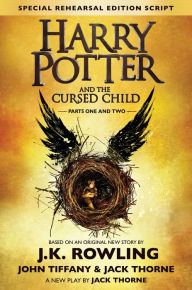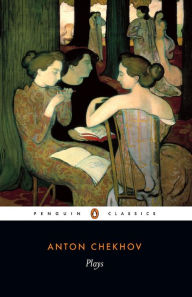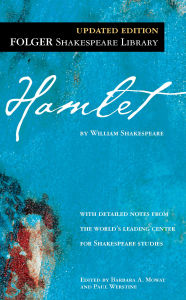Get the Most Out of Harry Potter and the Cursed Child with 6 Tips on How to Read a Play
Harry Potter and the Cursed Child - Parts I & II
Harry Potter and the Cursed Child - Parts I & II
By J. K. Rowling , John Tiffany , Jack Thorne
Hardcover $29.99
Harry Potter and the Cursed Child is set to hit London’s West End this summer, and the script book will be published on July 31st, making it the most hotly anticipated book since, well, the release of J.K. Rowling’s final Harry Potter novel in 2007. If sales figures are any indication, Cursed Child is set to be among the most widely read plays of all time. But so many of us probably haven’t read a play since Romeo and Juliet in high school…or maybe never at all. Since it’s a little different from reading a novel, here are some tips for getting the most out of reading Harry Potter and the Cursed Child Parts I & II.
Remember the stage.
A novel can take place over wide swaths of space and time—or even in a character’s mind. This is less easily managed in a play. Most are written to be presented in a proscenium arch-style theater: Up on a stage, in a virtual frame, as a presentation to the audience. If you’re reading a play rather than seeing it, you’re that audience. Consider what your perspective from a theater seat would be as you read. Visualize the play taking place in front of you as it unfolds.
Harry Potter and the Cursed Child is set to hit London’s West End this summer, and the script book will be published on July 31st, making it the most hotly anticipated book since, well, the release of J.K. Rowling’s final Harry Potter novel in 2007. If sales figures are any indication, Cursed Child is set to be among the most widely read plays of all time. But so many of us probably haven’t read a play since Romeo and Juliet in high school…or maybe never at all. Since it’s a little different from reading a novel, here are some tips for getting the most out of reading Harry Potter and the Cursed Child Parts I & II.
Remember the stage.
A novel can take place over wide swaths of space and time—or even in a character’s mind. This is less easily managed in a play. Most are written to be presented in a proscenium arch-style theater: Up on a stage, in a virtual frame, as a presentation to the audience. If you’re reading a play rather than seeing it, you’re that audience. Consider what your perspective from a theater seat would be as you read. Visualize the play taking place in front of you as it unfolds.
Waiting for Godot: A Tragicomedy in Two Acts
Waiting for Godot: A Tragicomedy in Two Acts
In Stock Online
Paperback $16.00
Read it out loud.
Plays are meant to be performed. A lot of authorial intent may be too subtle to notice on the page, but it comes out when the dialogue is spoken. If there’s a passage you don’t quite understand, or if it just feels flat, read it out loud. You’ll get something more, or at least different, out of it. There’s also something to be said for getting a group together and reading an entire play out loud. Turn that book club into a Drama Club for one meeting!
Visualize the characters.
Plays generally don’t offer much in the way of character description other than a few notes about gender, age, and relationships to other characters. (Or not even that much, if it’s something like Waiting for Godot.) Novels offer long passages of character description, but most of us still end up picturing known quantities as we read, be they movie stars, people from our own lives, or ourselves. This is not just something your mind does when you read a play—it’s a viable trick to keep the characters straight in your head. With Harry Potter and the Cursed Child, though, you’ll have the benefit of being able to picture some of the characters from the films.
Read it out loud.
Plays are meant to be performed. A lot of authorial intent may be too subtle to notice on the page, but it comes out when the dialogue is spoken. If there’s a passage you don’t quite understand, or if it just feels flat, read it out loud. You’ll get something more, or at least different, out of it. There’s also something to be said for getting a group together and reading an entire play out loud. Turn that book club into a Drama Club for one meeting!
Visualize the characters.
Plays generally don’t offer much in the way of character description other than a few notes about gender, age, and relationships to other characters. (Or not even that much, if it’s something like Waiting for Godot.) Novels offer long passages of character description, but most of us still end up picturing known quantities as we read, be they movie stars, people from our own lives, or ourselves. This is not just something your mind does when you read a play—it’s a viable trick to keep the characters straight in your head. With Harry Potter and the Cursed Child, though, you’ll have the benefit of being able to picture some of the characters from the films.
Plays: Ivanov; The Seagull; Uncle Vanya; Three Sisters; The CherryOrchard
Plays: Ivanov; The Seagull; Uncle Vanya; Three Sisters; The CherryOrchard
By
Anton Chekhov
Translator
Peter Carson
Introduction
Richard Gilman
Noted by
Peter Carson
In Stock Online
Paperback $10.00
Keep your own list of characters handy.
That said, it’s also helpful write out a list of the characters of the play (also called the Dramatis Personae) on a sheet of paper and keep it close for handy reference as you read. Include details that will help you remember each person. (If you were reading Hamlet, you might write down “Claudius: King, Hamlet’s father” and “Laertes: Hamlet’s best friend.”) This idea is especially helpful for plays originally written in a language with which you are not familiar, or the plays of Anton Chekhov, where characters refer to each other by names, titles, nicknames, and Russian nicknames. You can also use your scratch paper to take notes about anything else in the play you might think will be important to remember.
Read it all at once.
Unlike novels, which are helpfully broken down into chapters, plays are not meant to be read in bits and pieces. They’re meant to be watched and consumed all at once (with maybe an intermission in the middle, so you can get snacks and stand in line for the bathroom). Read the entire play in one sitting to get the full literary and theatrical impact. If that’s not quite possible for your schedule, however, at least try to read an entire act all at once.
Keep your own list of characters handy.
That said, it’s also helpful write out a list of the characters of the play (also called the Dramatis Personae) on a sheet of paper and keep it close for handy reference as you read. Include details that will help you remember each person. (If you were reading Hamlet, you might write down “Claudius: King, Hamlet’s father” and “Laertes: Hamlet’s best friend.”) This idea is especially helpful for plays originally written in a language with which you are not familiar, or the plays of Anton Chekhov, where characters refer to each other by names, titles, nicknames, and Russian nicknames. You can also use your scratch paper to take notes about anything else in the play you might think will be important to remember.
Read it all at once.
Unlike novels, which are helpfully broken down into chapters, plays are not meant to be read in bits and pieces. They’re meant to be watched and consumed all at once (with maybe an intermission in the middle, so you can get snacks and stand in line for the bathroom). Read the entire play in one sitting to get the full literary and theatrical impact. If that’s not quite possible for your schedule, however, at least try to read an entire act all at once.
Hamlet (Folger Shakespeare Library Series)
Hamlet (Folger Shakespeare Library Series)
By
William Shakespeare
Editor
Dr. Barbara A. Mowat
,
Paul Werstine Ph.D.
In Stock Online
Paperback $6.99
Add to the experience.
After you’ve read the play, track down academic essays about the work, or seek out critical reviews. These extra texts can help you notice something you might have missed. Because you probably will miss something. Plays come alive when they’re performed; reading the script is only part of the experience, and one that can feel like you’re wearing blinders. If you’re planning to read Harry Potter and the Cursed Child, it might not be produced anywhere near where you live any time soon. But so what? Go see any play. An evening at the theater will familiarize you with the tropes and rhythms of plays, which will help inform the experience the next time you read a play.
Are you excited to read Harry Potter and the Cursed Child?
Add to the experience.
After you’ve read the play, track down academic essays about the work, or seek out critical reviews. These extra texts can help you notice something you might have missed. Because you probably will miss something. Plays come alive when they’re performed; reading the script is only part of the experience, and one that can feel like you’re wearing blinders. If you’re planning to read Harry Potter and the Cursed Child, it might not be produced anywhere near where you live any time soon. But so what? Go see any play. An evening at the theater will familiarize you with the tropes and rhythms of plays, which will help inform the experience the next time you read a play.
Are you excited to read Harry Potter and the Cursed Child?



